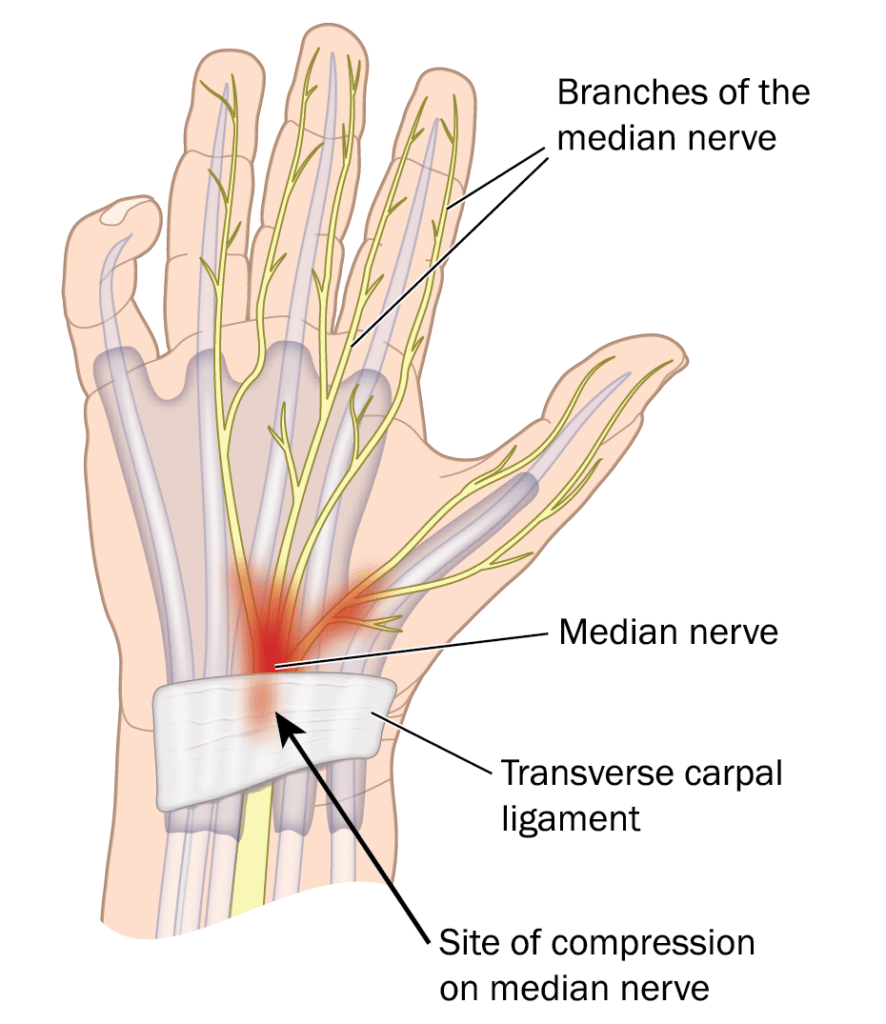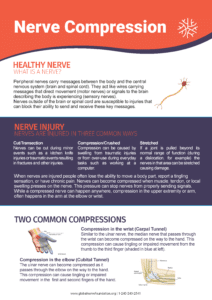Carpal Tunnel

Slide

Slide
Carpal Tunnel
Numbness and Tingling caused by the Median Nerve
Numbness and tingling of the hands are common and bothersome symptoms. Such tingling can be temporary. For example, tingling in your arm could result from your arm being under your head as you fall asleep. The tingling symptom is relieved by repositioning your arm. In many cases, however, numbness or tingling in the hands can be persistent and severe and can interfere with daily activities. Other symptoms such as pain, weakness, and dropping things may be present or show up later. In such cases, tingling may signal nerve irritation or damage.
There are several causes for nerve problems, some of which are reversible and some are not. Sensation and motor function to the hand is supplied by three major nerves. These nerves are the median, ulnar, and radial nerves. These nerves reach from the neck, across the elbow, and the wrist, until they reach the fingertips.
On the way through the arm and hand, these nerves cross one or more ‘tunnels’. Nerve compression across an anatomic tunnel is called a tunnel syndrome. Common areas for nerve compression are across the wrist (the carpus), and across the elbow (the cubitus) thus the names Carpal Tunnel Syndrome. Numbness caused by compression of the ulnar nerve being compressed in the cubital tunnel is referred to as Cubital Tunnel Syndrome. Click here to learn more about cubital tunnel syndrome.
On the way through the arm and hand, these nerves cross one or more ‘tunnels’. Nerve compression across an anatomic tunnel is called a tunnel syndrome. Common areas for nerve compression are across the wrist (the carpus), and across the elbow (the cubitus) thus the names Carpal Tunnel Syndrome. Numbness caused by compression of the ulnar nerve being compressed in the cubital tunnel is referred to as Cubital Tunnel Syndrome. Click here to learn more about cubital tunnel syndrome.
Click below to download our GNF handout on nerve compression
Carpal Tunnel Syndrome
Listen to our Physician Roundtable talk about the biology of the median nerve and the anatomy of carpal tunnel syndrome.
The carpal tunnel is located at the palm side of the wrist (circled on the image at left). The bottom and sides of this tunnel are by wrist bones and the top is made of a strong ligament. The median nerve (highlighted in yellow at left) passes through the carpal tunnel before it reaches the fingertips. It provides feeling to the thumb, index, long,and one half of the ring finger. It also controls the muscles of the thumb. The nerve is accompanied by a total of nine formed tendons that also reach to the fingers and thumb.
Carpal tunnel syndrome occurs when the pressure in the tunnel increases. Usually, this is caused by swelling of the tissues around the nerve.
Carpal tunnel syndrome occurs when the pressure in the tunnel increases. Usually, this is caused by swelling of the tissues around the nerve.
Testing for Carpal Tunnel Syndrome
Symptoms of carpal tunnel syndrome include numbness, tingling, ‘pins and needles’, pain, and electric shock-like feeling in the thumb, index, and middle fingers. Symptoms usually start gradually, get worse at night, and get worse with time. Patients may wake up at night because of it and sometimes notice partial relief with shaking the hand. With time, the hand may get clumsy, and patients start dropping things, and have difficulty holding objects because they cannot feel with their fingertips.
Listen to our Physician Roundtable talk about nerve testing to identify carpal tunnel syndrome.
Listen to our Physician Roundtable discuss how patients can be tested to determine if they have carpal tunnel syndrome.
Listen to our Physician Roundtable discuss what is looked for when using ultrasound to diagnosis carpal tunnel syndrome.
Unfortunately, many patients assume that numbness and tingling is something that comes with age, and just live with it. This is not true, as carpal tunnel syndrome is easy to deal with and should always be addressed. If carpal tunnel is ignored for a long time, irreversible damage can occur and shows as flattening of the thumb muscles and weakness of grip and pinch.
Listen to our Physician Roundtable discuss how hand weakness could be a sign of carpal tunnel syndrome.
Sign up to be notified when new educational content is available!
Non-Surgical Treatment
Non-surgical treatment for carpal tunnel syndrome can be very simple. Treatment usually involves a combination of a steroid injection and a semi-rigid wrist splint. However, if symptoms persist or recur, the injection may be repeated or surgery may be considered.
Listen to our Physician Roundtable discuss non-surgical treatments for carpal tunnel syndrome.
Surgical Treatment
Listen to our Physician Roundtable discuss surgical treatments for carpal tunnel syndrome.
Typically, the surgery for carpal tunnel syndrome involves splitting the ligament on the top of the tunnel (pictured in green on the left) to make more room for the median nerve (pictured in yellow on the left). Often, a nerve test is used to confirm the diagnosis. Surgery for carpal tunnel syndrome does not require being put to sleep. It is most commonly performed under local anesthesia as an in-patient procedure.
If you are suffering from compression symptoms, be sure to consult a nerve specialist
PAGE CONTRIBUTORS
PAGE CONTRIBUTORS

Shafic Sraj, MD
Associate Professor, and Director, System Integration, Dept. of Orthopaedic Hand and Upper Extremity Surgery and Orthopaedic Sports Medicine
West Virginia University

Deana Mercer, MD
Professor, Orthopaedic Surgeon University of New Mexico

Amber Leis, MD
Associate Professor, UCI School of Medicine, Department of Plastic Surgery
University California, Irvine
The content on or accessible through globalnervefoundation.org is for informational purposes only. This information is not a substitute for professional advice or expert medical services from a qualified healthcare provider



